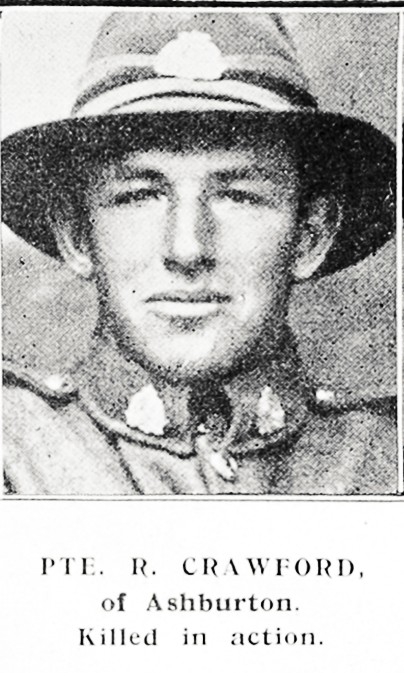Pte
Robert Crawford
Informatie over geboorte
|
Geboortedatum: 29/03/1894 |
|
Geboorteplaats: Christchurch, Canterbury, Nieuw-Zeeland |
Algemene Informatie
|
Beroep: Boerenknecht |
Informatie legerdienst
|
Land: Nieuw-Zeeland |
|
Strijdmacht: New Zealand Expeditionary Force |
|
Rang: Private |
|
Service nummer: 34638 |
|
Dienstneming datum: 23/08/1916 |
|
Dienstneming plaats: Featherston, Wellington, Nieuw-Zeeland |
|
Eenheden: — Canterbury Regiment, 3rd Bn. |
Informatie over overlijden
|
Datum van overlijden: 15/12/1917 |
|
Plaats van overlijden: Polygoonbos, Zonnebeke, België |
|
Doodsoorzaak: Killed in action (K.I.A.) |
|
Leeftijd: 23 |
Begraafplaats
|
Buttes New British Cemetery, Polygon Wood Plot: I Rij: A Graf: 15 |
Onderscheidingen en medailles 2
|
British War Medal Medaille |
|
Victory Medal Medaille |
Points of interest 3
| #1 | Geboorteplaats | ||
| #2 | Dienstneming plaats | ||
| #3 | Plaats van overlijden (bij benadering) |
Mijn verhaal
Robert Crawford was born in Yaldhurst (now a suburb of Christchurch) New Zealand on 29 March 1894, one of eight children of Thomas and Jessie Crawford. Robert was a farm hand near Ashburton, Canterbury (where his parents lived) when he enlisted on 23 August 1916 at Featherston Camp. He joined the 20th Reinforcement, training at Featherston and Trentham before departing on 7 December 1916 on the troop ship Port Lyttelton.
The 20th reinforcement arrived at Devonport, England on 18 February 1917 and the troops immediately began training at Sling Camp, on the Salisbury Plain. This group also trained at nearby Codford Camp as part of the 4th NZ Brigade. Robert was posted to 2nd Company, 3rd Canterbury Regiment, which left for France on 28 May 1917.
By September 1917 the New Zealand Division was preparing to fight at the battles of Broodseinde and Passchendaele. Robert’s battalion was part of 4th NZ Brigade and took part on the attack on Gravenstafel on 4 October. It is not known if he was personally involved.
The New Zealand Division was in the Polygon Wood area after the end of the Third Battle of Ypres. Much of the time was spent in wiring, repairing crumbling trenches and improving defences. The landscape was covered with waterlogged shellholes. The right of the New Zealand position was enfiladed from Polderhoek and a decision was made to capture the spur on which the ruins of Polderhoek Chateau and German pillboxes sat.
After the unsuccessful attack on Polderhoek on 3 December, the various battalions took turns in the line and in reserve. Neither the New Zealand Division history or that of the Canterbury Regiment give detailed information for the December 1917-February 1918 period so it is impossible to say with any certainty how Robert Crawford died on 15 December 1917. The opposing German forces generally held higher ground and movement in the New Zealand lines was often observed and shelled or machine-gunned. On the night of 15/16 December the 3rd Canterbury Battalion relieved the 1st Canterburys at Polygon Wood and it was here that Robert was killed.
His body was retrieved and buried nearby. He is now in the same area, at Buttes New British Cemetery, Plot I, Row A, Grave 15.
The 20th reinforcement arrived at Devonport, England on 18 February 1917 and the troops immediately began training at Sling Camp, on the Salisbury Plain. This group also trained at nearby Codford Camp as part of the 4th NZ Brigade. Robert was posted to 2nd Company, 3rd Canterbury Regiment, which left for France on 28 May 1917.
By September 1917 the New Zealand Division was preparing to fight at the battles of Broodseinde and Passchendaele. Robert’s battalion was part of 4th NZ Brigade and took part on the attack on Gravenstafel on 4 October. It is not known if he was personally involved.
The New Zealand Division was in the Polygon Wood area after the end of the Third Battle of Ypres. Much of the time was spent in wiring, repairing crumbling trenches and improving defences. The landscape was covered with waterlogged shellholes. The right of the New Zealand position was enfiladed from Polderhoek and a decision was made to capture the spur on which the ruins of Polderhoek Chateau and German pillboxes sat.
After the unsuccessful attack on Polderhoek on 3 December, the various battalions took turns in the line and in reserve. Neither the New Zealand Division history or that of the Canterbury Regiment give detailed information for the December 1917-February 1918 period so it is impossible to say with any certainty how Robert Crawford died on 15 December 1917. The opposing German forces generally held higher ground and movement in the New Zealand lines was often observed and shelled or machine-gunned. On the night of 15/16 December the 3rd Canterbury Battalion relieved the 1st Canterburys at Polygon Wood and it was here that Robert was killed.
His body was retrieved and buried nearby. He is now in the same area, at Buttes New British Cemetery, Plot I, Row A, Grave 15.
Bronnen 3
|
Auckland Weekly News http://www.aucklandcity.govt.nz/dbtw-wpd/heritageimages/index.htm Gebruikte bronnen |
|
Births deaths marriages New Zealand https://www.bdmhistoricalrecords.dia.govt.nz/ Gebruikte bronnen |
|
Ferguson David, The history of the Canterbury Regiment, NZEF 1914-1919, (Auckland, Whitcombe & Tombs Ltd, 1921), pg. 218-223. Gebruikte bronnen |
Meer informatie 5
|
Commonwealth War Graves Commission Database https://www.cwgc.org/find-records/find-war-dead/casualty-details/480172 |
|
Namenlijst (In Flanders Fields Museum) https://namenlijst.org/publicsearch/#/person/_id=34bc019b-82f7-4f58-bcc8-73dc80cd0c85 |
|
Lives of the First World War (Imperial War Museum) https://livesofthefirstworldwar.iwm.org.uk/lifestory/7173088 |
|
The NZEF Project (UNSW Canberra) https://nzef.adfa.edu.au/showPerson?pid=56816 |
|
Online Cenotaph (Auckland Museum) https://www.aucklandmuseum.com/war-memorial/online-cenotaph/record/c3380 |
